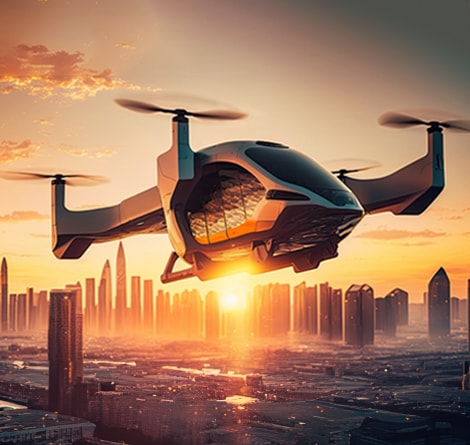
TE Perspectives
To See the Future of Electric Vehicles, Look to the Sky
Author: Ron Port, President, Aerospace, Defense & Marine
Electric vertical takeoff and landing (eVTOL) aircraft could reshape urban mobility in the coming years — and change how we traditionally think of aircraft design. Imagine flying into O'Hare International Airport and getting to downtown Chicago without battling traffic. Starting as early as 2025, United Airlines plans to make this possible with a fleet of battery-powered eVTOLs, a new class of aircraft that resembles a cross between an electric passenger vehicle and an oversized drone featuring an interior similar to a luxury automobile.
Initially, these eVTOL "air taxis" will operate similarly to helicopters because they will use helipads and follow similar flight rules, but the similarities between the two aircraft end just about there. The design of these new aircraft owes a debt to advancements made in consumer and commercial-grade electric vehicles. In fact, most models under development for the near future resemble very comfortable cars that seat between two and six passengers, rather than a cramped helicopter or small aircraft.
Developing an eVTOL isn't the same as developing an EV, nor is it like developing a traditional airplane. Making an “electric car” fly requires optimization of weight and range. Every ounce of weight counts when you're lifting something into the air. The farther you want to go, the bigger the batteries you'll need to get there — and bigger batteries mean more weight all on their own. Charging time is also a critical consideration: The sooner you can get an eVTOL back in the air, the sooner it can get back to generating revenue.
These considerations also have shaped the emerging business model for eVTOLs, focusing them on shorter trips that transport relatively small numbers of passengers. As a result, companies designing and building these aircraft have a different focus versus traditional aerospace manufacturers – they drive for quicker iterations in design, testing and certification of model-specific systems.
In a fast-paced process that still requires impeccable reliability and safety standards, TE Connectivity's extensive experience developing materials and products qualified for use in EVs and aerospace environments allows us to work thoughtfully with customers on eVTOL development opportunities where we can add value and innovate.

New Class of Components for a New Class of Aircraft
Some elements of eVTOLs transfer nearly directly from other applications. For example, commercial electric vehicles' charging components and systems are relatively easily adapted for use on an aircraft. However, the demands eVTOLs face in the skies are much different than you see on a highway.
eVTOLs will be expected to perform frequent, short flights at relatively low altitudes. These conditions require extremely durable components. Of course, safety, quality and reliability are critical attributes of parts manufactured for any vehicle. Still, they take on added importance as these aircraft fly over heavily populated areas at relatively low altitudes. Therefore, a durable, reliable high-voltage power distribution system is essential.
TE is meeting this demand by offering power distribution units and power switching contactors, as well as electrical and fiber optic cables to connect the power distribution, avionics and infotainment systems to help make these aircraft safe, reliable and comfortable. In addition, we are optimizing high-voltage connectors developed to withstand the rigors of aerospace applications to enable them to handle the 100 to 600 kilowatts needed to power this early generation of eVTOLs.
As we work with engineers to optimize their eVTOL designs, we can bring our experience to bear on seemingly minor details that can make a substantial difference. For example, moving from round cables to flat ones reduces weight, improves thermal characteristics, provides greater cable flexibility and takes up less space within the airframe, leaving more room for passenger comfort.
Different Approach to Aircraft Design
Compared to traditional aircraft manufacturers, the companies developing eVTOLs tend to look for a different type of partnership with their component suppliers. Because they generally follow Agile design principles, eVTOL developers want to generate new iterations of their designs within days, rather than weeks or months. As a result, these developers are more comfortable integrating commercial off-the-shelf parts into their designs, saving manufacturing costs upfront and reducing maintenance costs for replacement parts.
Manufacturers like TE can complement this desire to move quickly with engineering knowledge from a long history of designing and integrating components in aviation systems. That knowledge allows us to guide eVTOL engineers as they work to accelerate development cycles without compromising on safety. In addition, our experience developing parts for adjacent industries, such as commercial and passenger vehicles, also means we can help eVTOL manufacturers think beyond traditional aerospace norms as they develop the new systems that will power a whole new class of vehicles.
Scalability will be Key to Revolutionizing Urban Travel
The eVTOL industry will likely need to develop some level of standardization among its components to scale rapidly and reach its full potential. No matter how different the designs look cosmetically, they all face the same core design challenges: size and weight optimization, power distribution, safety, durability and reliability.
Initially, eVTOLs will likely fly like a helicopter with electronic components to make their control systems familiar to veteran pilots. They will also be small, because size and weight will govern the cost and capacity of each vehicle.
There's an advantage in starting small, however. Solving the challenges in a small vehicle provides more opportunities to get everything right before expanding capacity and range. As crucial as rapid development may be to getting the first eVTOL fleets off the ground, designing components with an eye toward the future will be important to the market's continued success.
Furthermore, we can design the components we use to build these aircraft with an eye toward their potential use in larger airframes over time. Battery density remains a key practical hurdle to producing larger, longer-haul electric aircraft.
By continuing to improve components that can safely and reliably handle higher voltages while minimizing weight and space, the urban taxi that flies you from the airport to the city center could quickly evolve into something more like a regional bus or an intra-urban high-speed train when the next generation of battery technology arrives. With relatively limited practical infrastructure needs, outside of a place to land and the ability to charge its batteries, there's potential to revolutionize how people travel in ways we haven't seen since the introduction of the jet engine.
With the Right Parts, the Sky's the Limit
eVTOLs could change how we think about urban mobility by offering a new, sustainable link between cities and suburbs. To the extent that they become accepted in the market and can scale in size, they also offer a step toward a more sustainable form of commercial air travel. Thoughtfully engineered designs that create a new standard of safety and comfort will be the key to getting this new class of vehicles off the ground — and keeping eVTOLs in the air for many years to come. TE will be innovating right along side.
About the Author

Ron Port
Ron Port is the President of Aerospace Defense & Marine with TE Connectivity. In this role, he is responsible for the growth and profitability of the business. Prior to serving in this capacity, Ron has spent the last 15 years in general management roles with industrial business to business companies. In total, he has nearly 25 years of experience across general management, strategy, sales and marketing, engineering, operations and corporate business development. Ron holds a Bachelor of Science degree in chemical engineering from the University of Pittsburgh, a Master of Business Administration from the University of Pittsburgh, and a Master's degree in chemical engineering from the Florida Institute of Technology.
More Stories on Tech Innovation




 e
e

